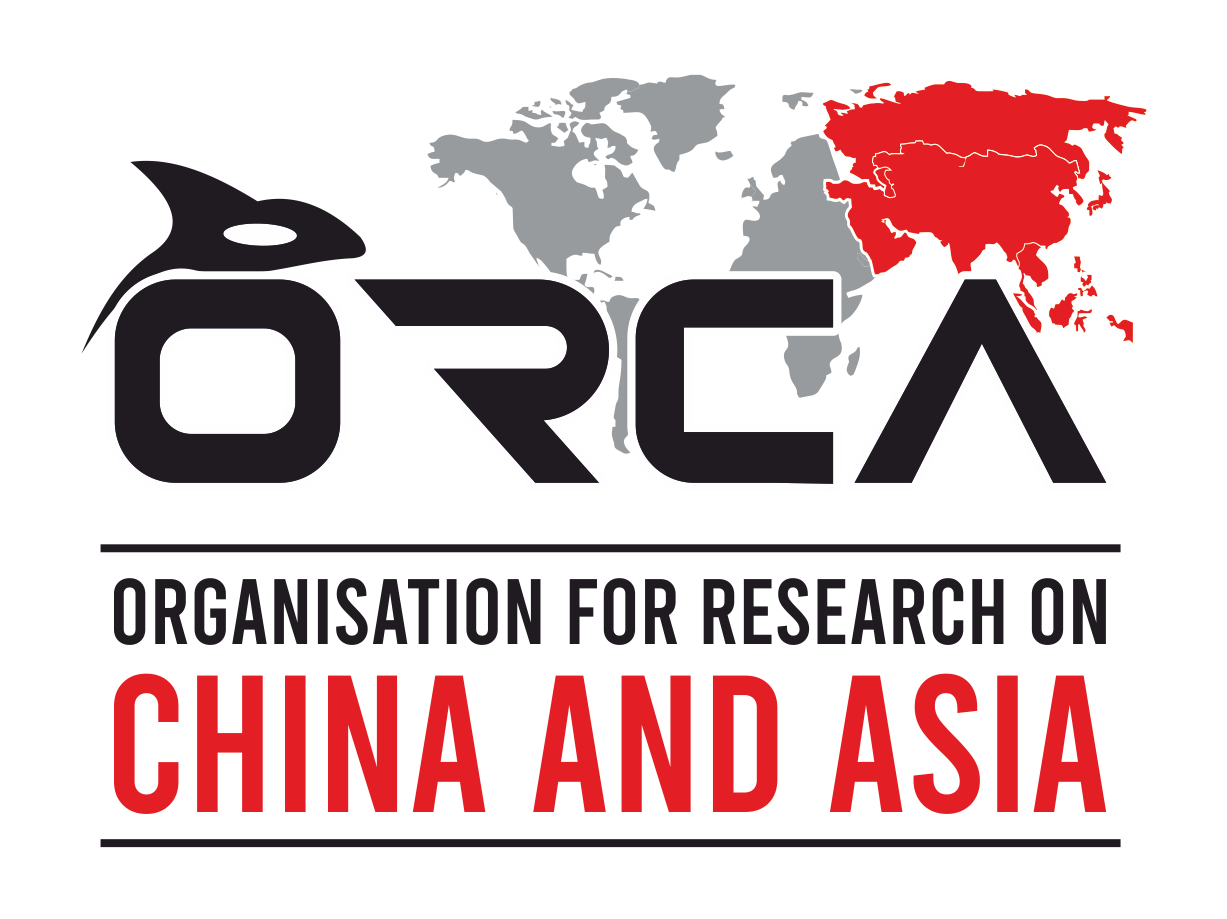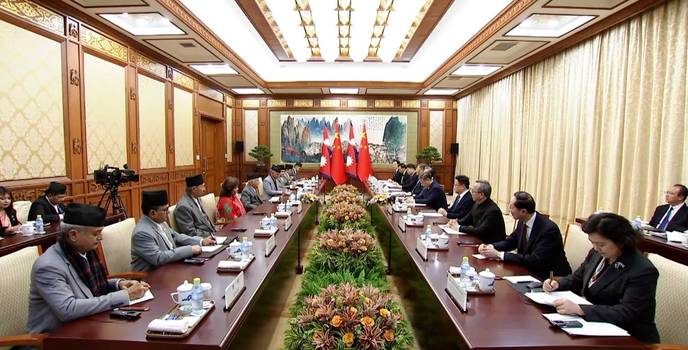Nepali Prime Minister KP Oli’s latest China visit between December 2 to 5 was perceived as a major shift in Nepal’s foreign policy. His decision to not choose India for his first state visit —a tradition that has been upheld by Nepali PMs previously —has sent up warning signs in India. Nonetheless, amidst New Delhi’s reluctance to extend a formal invitation to PM Oli to visit India, his decision to choose Beijing should not come as a surprise, especially given his pro-China actions in past tenures. For instance, as the leader of Nepal’s Communist (Unified Marxist-Leninist) Party, his closeness to Beijing often came at the cost of India-Nepal relations, evident from instances such as the 2015 fuel supply agreement and the 2016 transit agreement with China, which aimed to diversify away from India.
PM Oli’s latest four-day visit was important for Nepal mainly from two perspectives. First, it aimed to project Nepal’s balancing act between India and China which implies reducing its heavy economic dependency on India and attracting more trade and investments from China. However, despite several efforts by Nepal in this direction in the past few years, the India factor remains integral in Nepal’s foreign policy, also reflected from the fact that Chinese coverage of this visit majorly focused on the perceived tensions in India-Nepal relations. Secondly, PM Oli was also expected to make progress on Belt and Road Initiative (BRI) projects that have been stalled since the signing of the initial MoU in 2017. In this regard, China and Nepal succeeded in signing the cooperation framework agreement on BRI, applicable for the next three years. However, doubts regarding the success of its implementation still loom large due to several unresolved challenges. Thus, although both China and Nepal hailed this visit for “injecting a new impetus into the development of bilateral relations”, has the visit achieved these desired objectives? and was it able to mitigate challenges in China-Nepal relations?
BRI’s Inroads in Nepal
The latest BRI framework agreement calls for upholding technical, commercial and economic viability of projects, thereby slashing down several ambitious projects initially identified under the framework. The joint statement issued during the visit mentioned several Chinese-funded projects in Nepal that are at different stages of implementation. But the Nepali media reported that the agreement facilitates negotiations for 10 projects to be prioritised under the BRI framework which range from ambitious cross-border rail and power transmission projects to even projects such as sports complex and city hall. Out of these projects, agreement was reached for the implementation of the Tokha-Chhahare tunnel project as a part of nine-point agreement signed during the visit.
Nevertheless, one of the most important hurdles hindering BRI’s progress in Nepal is the financing modalities. In this regard, differences of perception between Nepal and China were visible till the last moment which led to the delay in signing of the agreement. While this visit aimed to bridge these differences, it seemed to have achieved limited success as the agreement mentions the term “aid assistance financing”, leaving it vague for both sides to interpret on their own terms. Nepal’s current external debt stands at 21.8 percent of GDP, well below the nationally mandated limit of 33 percent of which China currently accounts for less than 1 percent behind Japan and India. As a result, Nepal’s debt carrying capacity is considered strong which is largely accrued to concessional loans from global multilateral creditors, constituting around 90 percent of Nepal’s total creditors. Nepal aims to continue this economic resilience and thus, have reservations about accepting high-interest loans from China. However, while PM Oli assured that the visit did not involve signing of any loan agreement with China in line with his announcement before the visit, the term “aid assistance” does not explicitly rules out loans and thus, may create frictions while ideating future BRI projects due to differences in interpretations.
From the Chinese side, conceding to Nepal’s demand for “grant” for all BRI projects could have set a precedent for other BRI countries to seek similar waiver as around 80 percent loans by Chinese institutions are granted to countries facing debt distress. Further, China’s interests in Nepal transcend mere commercial gains as it views Nepal as a crucial partner in the Himalayan geopolitical game against India and thus, it cannot afford to show complete inflexibility while dealing with Nepal. China’s agreement on aid assistance appears to have emerged from these compulsions, thereby hinging its success on long term geopolitical advantage instead of short-term commercial gains.
Persisting Challenges
As China hopes to promote BRI in its Himalayan neighbour, challenges such as gaps in planning and implementation, delays and consequent cost overruns, lack of political consensus over BRI have stalled its progress till now. In fact, even amongst projects prioritised during the visit, the Kerung-Kathmandu railway line, originally proposed in 2018, has not completed its feasibility study yet. Moreover, a pre-feasibility study showed that complex terrains along the proposed route may lead to significant cost increase over USD 3-3.5 billion. As the project continues to get delayed, there are further risks of cost overruns. Moreover, projects such as sports and athletics complex in Jhapa and a city hall in Amargadhi aim to serve domestic constituencies of PM Oli and foreign minister Arzu Rana Deuba respectively and thus, may carry a risk of being commercially unviable. Hence, despite the common consensus reached between Nepal and China on BRI, these challenges will continue to hinder its progress.
More importantly, PM Oli was expected to convince the Chinese side to convert the USD 216 million loan taken for Pokhara international airport into a grant. Although Nepal does not consider this as a BRI project, the Chinese ambassador touted this project as a part of BRI after its completion. With its repayment scheduled to begin from 2026, demands for its conversion into a grant were made by previous Nepali governments at different levels. But considering PM Oli’s closeness to Beijing, Nepal’s political leaders were hopeful that the demand would be fulfilled this time. To everyone’s surprise, no such decision was reached during the visit, thereby continuing the project to be a thorn in China-Nepal relations due to uncertainty surrounding repayment amidst low revenues and other headwinds such as local protests and financial irregularities.
Challenges for BRI projects in Nepal also stem from its alliance-based domestic political situation. Nepali Congress, the largest party in the current ruling coalition, has continuously opposed loans for BRI projects which also compelled PM Oli to conform to this position publicly before the visit. However, the ambiguity regarding the term aid assistance has led Nepali Congress leaders to criticize PM Oli for departing from common consensus reached between ruling parties. Furthermore, considering Nepal’s political alliance system, PM Oli may have to concede to demands of Nepali Congress which is largely seen as a pro-India party. This can further affect the already sluggish growth of BRI, thereby limiting the successful implementation of consensus reached during the visit.
Inevitable India Factor
While Oli’s visit was projected as an indicator of strained India-Nepal relations, it would be an overstatement considering stronger foundations of these ties, rooted not only in history but also in fulfilling modern developmental needs. India has continued to expand its relations with Nepal in multiple domains including electricity exports, cooperation for renewable energy, hydropower projects and more. Most recently, Nepal and India reached an agreement for cross-border electricity trade from Nepal to Bangladesh. This will allow Nepal to earn an annual income of around USD 9.2 million and reduce its trade deficit with Bangladesh. While China-Nepal struggles to form consensus on financing modalities for development projects, India has already invested over INR 780 crore (USD 92 million) in grants for 551 high impact development projects since 2003. Moreover, although PM Oli’s bilateral visit to India could not happen this year, he met PM Modi in September 2024 on the sidelines of UNGA where both leaders discussed matters related to energy, technology and trade.
Thus, Oli’s Beijing visit amidst these developments in India-Nepal relations is unlikely to affect Nepal’s relations with India. India-Nepal ties are based on its own foundational pillars and need not always run counter to developments in China-Nepal relations. This realisation is also reflected from Oli’s pre-visit statement highlighting that his China tour would not affect Nepal’s relations with India.
Moreover, Oli’s turn to China is marred with several inherent challenges affecting bilateral relations, particularly with regards to BRI projects. In fact, Nepal had sought India’s help to make China-built Pokhara airport commercially viable which underscores the inevitability of India in Nepal’s development trajectory. Thus, while Oli’s Beijing visit achieved some success in advancing BRI at least on paper in Nepal, hurdles in its implementation and moreover, stronger foundations of India-Nepal relations will continue to limit the strengthening of China-Nepal relations.
Image source: Xinhua



Author
Omkar Bhole
Omkar Bhole is a Senior Research Associate at the Organisation for Research on China and Asia (ORCA). He has studied Chinese language up to HSK4 and completed Masters in China Studies from Somaiya University, Mumbai. He has previously worked as a Chinese language instructor in Mumbai and Pune. His research interests are India’s neighbourhood policy, China’s foreign policy in South Asia, economic transformation and current dynamics of Chinese economy and its domestic politics. He was previously associated with the Institute of Chinese Studies (ICS) and What China Reads. He has also presented papers at several conferences on China. Omkar is currently working on understanding China’s Digital Yuan initiative and its implications for the South Asian region including India. He can be reached at [email protected] and @bhole_omkar on Twitter.